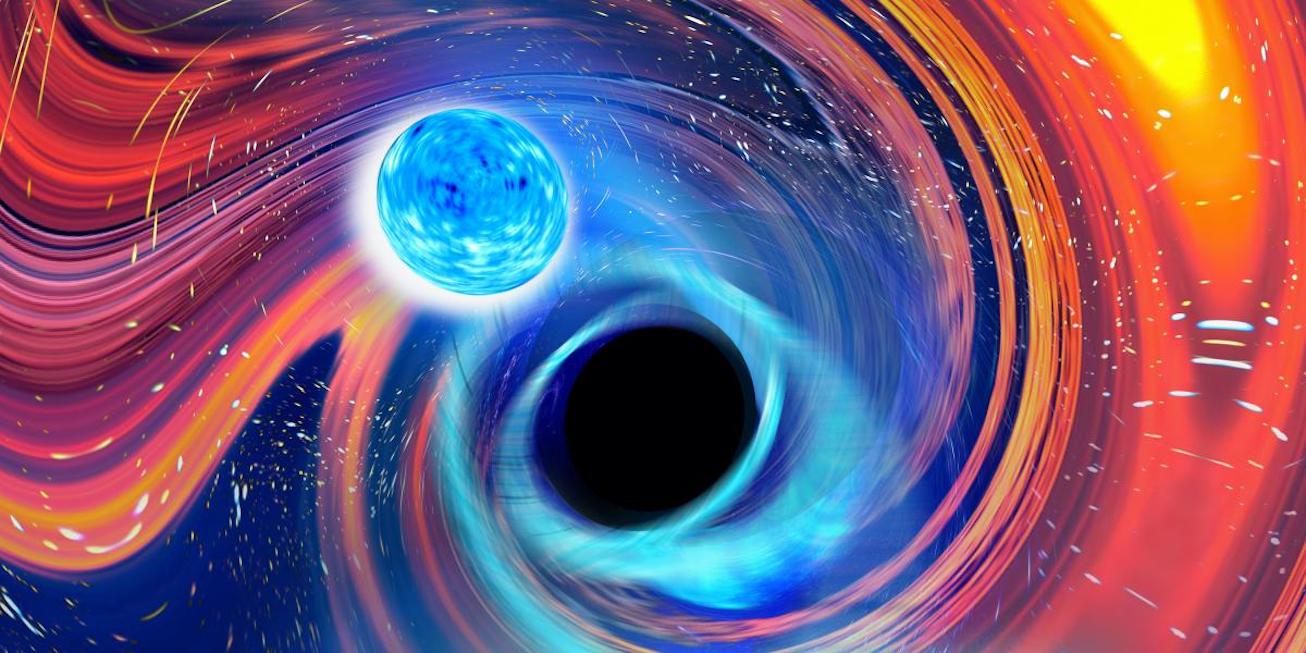New gravitational wave signal helps fill the ‘mass gap’ between neutron stars and black holes
April 8, 2024

April 8, 2024

A collaboration of researchers including UBC scientists have observed gravitational waves from the collision of what is most likely a neutron star and an object likely to be a light black hole, 650 million light-years from Earth.
The mass of the black hole is 2.5 to 4.5 times the mass of Earth’s sun, meaning it falls in the so-called ‘mass gap’: heavier than heaviest known and theorized neutron stars but lighter than the lightest black holes in our galaxy.
The collision, reported in a preprint paper, was detected by one part of an international network of gravitational wave detectors, comprised of the Laser Interferometer Gravitational-Wave Observatory (LIGO), the Virgo Gravitational Wave Interferometer, and the Kamioka Gravitational Wave Detector (KAGRA).
"This detection, the first of our exciting results from the fourth LIGO-Virgo-KAGRA observing run, reveals that there may be a higher rate of similar collisions between neutron stars and low mass black holes than we previously thought," says Dr. Jess McIver, assistant professor at UBC and deputy spokesperson of the LIGO scientific collaboration.
The ‘mass gap’, spanning roughly three to five solar masses, was thought to separate two types of cosmic ‘compact objects’: neutron stars and black holes. However, this observation, termed GW230529, demonstrates that there is more to the long-standing theory than an empty gap.
The researchers found the detected signal came from the merger of two compact objects, one with a mass between 1.2 to two times that of our sun and the other slightly more than twice as massive. While the gravitational-wave signal does not provide enough information to determine with certainty whether each of these compact objects are neutron stars or black holes, it seems likely that the lighter object is a neutron star and the heavier object a black hole. That suspected black hole sits square in the middle of the ‘mass gap’.
“While previous evidence for mass-gap objects has been reported both in gravitational and electromagnetic waves, this system is especially exciting because it’s the first gravitational-wave detection of a mass-gap object paired with a neutron star,” said Dr. Sylvia Biscoveanu, Einstein Fellow at Northwestern University and LIGO researcher. “The observation of this system has important implications for both theories of binary evolution and electromagnetic counterparts to compact-object mergers.”
Before the direct detection of gravitational waves in 2015, the masses of stellar-mass black holes were primarily found using X-ray observations while the masses of neutron stars were found using radio observations. The resulting measurements largely fell into two distinct ranges on either side of the ‘mass gap’. Over the years, a small number of measurements have encroached on the mass gap, which remains highly debated among astrophysicists.
“The finding shows us there’s a lot left to learn about these stellar remnants,” said Dr. McIver. “With gravitational wave detectors, we’re just starting to scratch the surface of what’s out there, filling in the true population of these stellar bodies.”
The signal was detected in May 2023 as part of the fourth observing run of the LIGO-Virgo-KAGRA network. Detecting objects in the mass gap is possible thanks to more sensitive detectors. As part of UBC’s LIGO effort, a team of Blusson QMI researchers are working towards improving the performance of mirror coatings for future use in LIGO detectors.
“Detector scientists, technicians, engineers, and off-site personnel have worked extremely hard to upgrade the LIGO detectors and improve operations since the third observing run,” said Dr. Evan Goetz, LIGO collaborator and research associate in the UBC department of physics and astronomy. “We made improvements to the detectors, the cyberinfrastructure, and the analysis software which has allowed researchers to detect more signals from further away and extract more information about the extreme events that generate these signals.”
Moving forward, researchers will analyze the data from the first half of the observing run, including checking up on 80 significant signal candidates that have been identified.
“It’s been eight years since we announced the first direct detection of gravitational waves and we haven’t stopped making discoveries since,” said Dr. Heather Fong, UBC research associate.
We honour xwməθkwəy̓ əm (Musqueam) on whose ancestral, unceded territory UBC Vancouver is situated. UBC Science is committed to building meaningful relationships with Indigenous peoples so we can advance Reconciliation and ensure traditional ways of knowing enrich our teaching and research.
Learn more: Musqueam First Nation